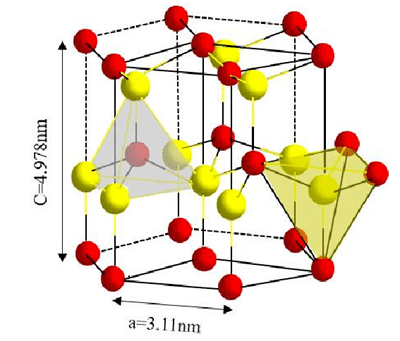Aluminum Nitride (AlN) is a covalent-bonded compound with a stable hexagonal wurtzite crystal structure and no other homotypic heterophases. Its crystal structure consists of AlN4 tetrahedra formed by aluminum atoms and adjacent nitrogen atoms. The space group is P63mc, belonging to the hexagonal crystal system.

Various factors influencing the thermal conductivity of AlN ceramics substrates include:
- Purity of the material
- Internal defects such as dislocations, voids, impurities, and lattice distortions
- Grain orientation
- Sintering process
In practical production, the actual thermal conductivity of AlN is often lower than its theoretical value of 319 W/(m·K) at 300K due to the mentioned factors.
Influence of Microstructure on Thermal Conductivity
The thermal conductivity of AlN is mainly affected by factors such as grain boundaries, interfaces, second phases, defects, electrons, and phonon scattering within the crystal. The thermal conduction mechanism in AlN is phonon-mediated, and the thermal conductivity is directly proportional to the average phonon mean free path. Minimizing crystal defects and impurity content is desirable for achieving high thermal conductivity in AlN ceramics.
The Influence of Oxygen Impurity Content on Thermal Conductivity
Research has shown that oxygen impurities significantly impact the thermal conductivity of AlN. Oxygen atoms replace nitrogen atoms, forming aluminum vacancies and oxygen defects. Oxygen concentrations below 0.75% create aluminum vacancies, while concentrations above 0.75% lead to octahedral defects. Higher oxygen concentrations can cause extended defects like polymorphism, inversion domains, and oxygen-rich stacking faults. Oxygen levels in AlN are influenced by the Gibbs free energy of the alumina reaction, with lower concentrations enhancing thermal conductivity. Thus, oxygen impurities are crucial in reducing AlN's thermal conductivity.
Appropriate sintering aids can improve thermal conductivity.
To enhance the thermal conductivity of AlN, it is common practice to add sintering aids during the sintering process. These aids help lower the sintering temperature, eliminate oxygen from the lattice, and ultimately improve the thermal conductivity of AlN.
Currently, there is significant interest in using multi-component sintering aids. Experimental studies have shown that adding composite sintering aids such as Y2O3-Li2O, Y2O3-CaC2, Y2O3-CaF2, and Y2O3-Dy2O3 to AlN can lead to denser samples with reduced oxygen impurities and second phases.
Choosing the appropriate composite sintering aids can achieve lower sintering temperatures for AlN and effectively purify the grain boundaries, resulting in AlN samples with higher thermal conductivity.
Heeger Materials is a reputable supplier offering top-notch Aluminum Nitride (AlN) Ceramics and other Technical Ceramics products at competitive prices, which are widely used in research and science fields. If you're interested, feel free to contact us at [email protected] for a quote, and we guarantee a response within 24 hours.


